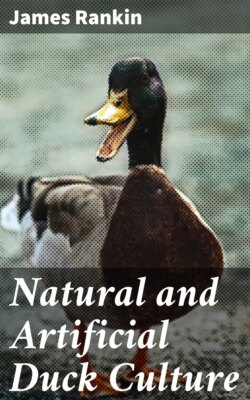Читать книгу Natural and Artificial Duck Culture - James Rankin - Страница 3
На сайте Литреса книга снята с продажи.
INTRODUCTION.
ОглавлениеTable of Contents
Our original motive in publishing this little book, was one of self-defense, to relieve ourselves, in a measure, of a correspondence which was becoming much too large for the time at our disposal. After reading from fifty to one hundred letters per day, from people, asking all manner of questions concerning the hatching, growing and marketing of ducks, in detail, there were not hours enough in the twenty-four to answer them. This book was published to send out with our machines to meet these queries and give our patrons our method of growing, supposing it would cover all the points in duck-culture, but it does not as yet answer the ends. The questions still come in far beyond our ability to answer, and as our fourth edition is about exhausted, we now publish a fifth, revised, enlarged and illustrated; also adding a Question Bureau, which will answer many of the questions which have reached us during the past few years concerning the growing, as well as the diseases to which the Pekin duck is subject. Though we have been in this business for nearly forty years, and have been eminently successful, we do not claim to know all about it; but by persistent effort, careful selection and breeding, have succeeded in developing a mammoth strain of Pekin ducks, which, for symmetry, precocity and fecundity (experts who have visited our place from all parts of the country tell us), stand unrivalled on this continent.
Many of our customers write us that their birds average from 150 to 165 eggs per season. We would say that there is no domestic bird under so perfect control, so free from diseases of all kinds, or from insect parasites as the Pekin duck. From the time the little bird is hatched until it is full grown and ready to reproduce its own species, it is under the perfect control of the intelligent operator, who can produce feathers, flesh or bone at will, and even mature the bird and compel it to lay at four-and-a-half months old. There is no bird in existence that will respond to kind treatment, generous care and feed as the Pekin duck. On the other hand, there is no bird more susceptible to improper feed or neglect, and a sad mortality is sure to follow among the little ones, where proper food and system are wanting. It may surprise some one to know that the predisposition to disease may exist in the egg from which the little bird is hatched, or even in the condition of the parent bird which produces the egg. Strong physique in animal life, as in man, are like exotics, requiring the most assiduous care and cultivation, and are the most difficult to transmit.
Defects, like weeds, seem indigenous to the soil and will reproduce with unerring regularity, and will often crop out in all directions, generations after you think you have wiped it all out. So it is one thing to produce an egg from good, strong, vigorous stock during the winter in inclement weather, when all nature is against you, and so poorly fertilized that if it hatches at all, will hatch a chick so enfeebled in construction that no amount of petting or coaxing can induce it to live, but quite another to produce an egg so highly vitalized, that it will be sure to hatch a healthy young bird, bound to live under all circumstances. But this is not all the danger. The operator, though he may have good eggs, may be neglectful or ignorant, and the health of the young birds seriously injured during the hours of incubation; or he may have a defective machine which under no condition can turn out healthy birds. With healthy, vigorous parent stock, judicious care and food, there is no reason why good hatches of strong, healthy young birds may not be obtained, and the same matured with very little loss.
